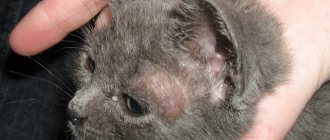With the onset of the warm season, the number of diseases caused by tick bites in cats increases sharply. With the onset of spring, pet owners begin to worry about how to protect their pet from this problem by any means. A tick bite in itself is not so terrible for a cat; dangerous pathogens are contained in the tick’s saliva, which can cause a number of dangerous and sometimes fatal diseases for a cat. Cats that walk through tall grass or dense bushes are especially at risk, where they are especially likely to pick up ticks. The tick that has just attached itself to the cat's skin is about the size of a pinhead. Over time, after he drinks blood, he grows to the size of a bean and is impossible not to notice.
General information about ticks. Ticks (Acarina) are small (0.1-30 mm) arthropods of the arachnid class (Arachnoidea) belonging to the largest group in the arthropod subclass, their number reaches 50 thousand species, most of which do not cause any harm to humans and animals. Ticks that parasitize cats are usually classified as carnivorous parasites, leading to the development of allergies, dermatitis, bacterial and viral diseases. Some ticks that attack cats drink blood, others chew the skin, and others feed on skin secretions and lymph. Cats are most often parasitized by three types of ticks:
Ixodidae (Ixodidae) are the largest ticks, which in a hungry state reach 2-3 mm in length, and after sucking blood - up to 1-1.5 cm. Scabies (internal, ear).
Subcutaneous (demodectic).
Mouth organs (piercing, gnawing, cutting, sucking). In all ticks they are formed by the first two pairs of limbs, chelicerae and pedipalgi; in ixodid ticks they consist of a pair of cutting chelicerae and a hypostome (an outgrowth of the lower edge of the mouth opening, covered with spines), tracheal or cutaneous respiration. Eyes are usually absent, less often there are 1-2 pairs. The stomach is saccular, in blood-sucking ticks with blind outgrowths that fill with blood during blood sucking. The excretory organs are represented by a pair of Malpighian vessels. Blood-sucking ticks have well-developed salivary glands, the secretion of which prevents blood clotting. All ticks are dioecious. The difference between females and males is well expressed, fertilization is internal. Most ticks are oviparous. The six-legged larva is the most characteristic feature of ticks.
The life of a tick can be roughly divided into four stages: egg, larva, nymph and adult. The total lifespan of a tick is about two months. After the tick drinks blood, it falls off and the larva begins to molt. Subsequently, the larva moves to the next stage of development, becoming a nymph; the nymph molts, turning into an adult tick, which is capable of leaving behind offspring. Ticks reproduce thanks to the female's ability to lay eggs. Considering that ticks that attack a cat multiply quickly and create optimal conditions for the development of bacteria and viruses, the owner should not delay treating the cat for ticks.
The process of a tick attacking a cat . Hungry ticks find their prey thanks to the presence of special thermal sensors. A cat passing by a bush or grass on which a tick is sitting becomes an object of attack; the tick makes a jump and, clinging to the hair, remains on the cat. Having latched onto a cat, the tick begins to look for a place on the body that is least covered with hair (skin around the ears, neck, legs, abdominal area, etc.). Further digging into the skin with its tentacles, the tick pierces the skin and begins the process of sucking blood. It becomes almost impossible to tear it away from the cat at this time, and only after the tick has completely drunk blood does it fall off the cat’s skin.
Subcutaneous mites in cats (demodex): what is it?
In domestic animals, askariasis is caused by different types of parasites. But the most commonly diagnosed is demodicosis - a chronic disease caused by Demodex cati and Demodex gatoi.
The arthropod is localized in the hair follicle, sweat (epocrine) and salivary glands. Larvae hatch from oocytes laid by females on days 4-6. After 7-10 days, individuals ready for reproduction grow. Pathogenic microorganisms live in colonies, forming painful nodules on the body of predators. Enlarged colonies cause atrophy of the sebaceous glands and disruption of skin functions.
There are two types of demodicosis: generalized and localized. The latter is characterized by damage to certain areas of the body: ears, eyes, chin and neck. Generalized spreads throughout the skin. This form is common in purebred Siamese and Burmese breeds.
Ixodidae
The Ixodid tick is the most common type of parasite and the largest. It has an oval body, which is covered with a chitinous shell, 8 legs and a disproportionately small head. The carapace covers about one third of the insect's body, which allows the elastic abdomen to expand 3 times when filled with the blood of the attacked animal. The main weapon of a tick is its proboscis with hooks (similar to fishing hooks), which allow it to gain a foothold in the body of the victim. Ticks remain on the animal from several days to 1 month.
At the moment of the bite, the tick injects a secret agent under the skin - saliva, which has an anesthetic effect. Therefore, the cat does not feel when ticks bite her, and gives the parasites time to securely attach themselves to the skin. After this, the tick on the cat begins to eat - it gains access to small blood vessels and sucks blood.
The flat black or dark brown body of the insect swells as it becomes saturated and looks like a large bead. The color also changes - from pinkish-gray to red and brown.
After satiation, the male tick detaches and goes to rest in a secluded place, and the female lays eggs in the wound and dies.
Causes of subcutaneous mites in cats
Ticks are part of animal life. Some live in hair follicles for years, feeding on dead epithelial cells. The predator's immune system controls the parasite population. If the pet is weakened, the body's protective functions reduce the ability to regulate the number of arachnids. Arthropods multiply rapidly, attacking healthy cells.
Factors influencing weakened immunity:
- helminthic infestations;
- hereditary or chronic diseases;
- unbalanced diet, lack of vitamins and minerals;
- improper maintenance and care (dirty litter);
- rare or lack of water procedures using antiparasitic agents.
Stress also reduces the body's protective functions.
Signs of illness
In its manifestations, damage to the subcutaneous mite is very similar to rosacea or acne. Peeling of the skin and its redness are noted, itching may occur, constant or worsening after using tonics or washing with cold water. Sometimes there is a combination of demodicosis caused by subcutaneous mites and the above-mentioned skin diseases. And this is not surprising, because the occurrence of demodicosis is influenced by negative changes in the skin. Thus, both acne vulgaris and rosacea weaken the skin’s natural defenses. When affected by skin mites, the following parts of the face are most often affected: eyelids, forehead, chin, nasolabial folds and brow ridges. Exacerbations of demodicosis occur in autumn and spring.
Subcutaneous mites in cats: routes of infection
Infection of a healthy predator occurs through direct or indirect contact with a sick one. Parasites are spread by using a shared brush to comb out wool and bedding. Microorganisms enter the apartment with clothing when a person comes into contact with an animal affected by arthropods.
Be sure to read:
How to deworm a cat: when to do it, how often, the best drugs and folk remedies
Routes of infection:
- direct contact with a sick predator;
- contact with the fur of a predator affected by demodicosis;
- intrauterine.
If a breeder has several pets, therapeutic measures are applied to all of them without exception.
Preventive methods of controlling parasites
It is better to prevent any disease than to treat it, but it is impossible to isolate yourself from the whole world. Even if your pussy sits at home, you can infect it by bringing mites on your clothes or the soles of your shoes. Compliance with preventive measures includes:
- Minimizing contact with stray animals;
- Balanced nutrition for the pet - dry food should be at least premium, and homemade food only from high-quality products;
- Regular examination of the animal's fur and skin - first of all, the groin area, ears, armpits;
- Maintaining hygiene - cleaning bowls, toys and beds.
- Cat breeders should not separate kittens from their mother for up to two months - along with milk, the offspring receive passive immunity, which protects the animal from pathogenic organisms.
It is advisable to sterilize pets who have recovered from the disease in order to avoid hormonal imbalances, complicated by relapses in the future. If a cat is carrying kittens and at the same time has contracted scabies, there is a possibility of giving birth to offspring with pathologies. Compliance with hygiene rules and basic prevention will reduce the risk of infection for your pet.
Animal risk group
Parasitic arachnids affect all predators, regardless of breed, sex, or age. A healthy pet with a strong immune system is not in danger. Under such conditions, the animal and arthropods are in an antagonistic relationship, where the cat’s body slows down the growth of parasitic microorganisms.
The following groups are susceptible to demodicosis:
- young individuals, especially those separated from their mother early;
- affected by leukemia and immunodeficiency viruses;
- with diagnosed immunosuppressive diseases (diabetes mellitus, toxoplasmosis);
- animals in the postoperative period;
- young offspring during the period of change of milk teeth to molars (4-6 months);
- exhausted after fasting;
- patients with rickets.
Stress caused by moving and frequent visits to the groomer negatively affects the health of the pet. The risk of ascariasis increases.
Can a cat die from a tick bite?
Are ticks dangerous for cats? The parasite itself does not pose a danger to the animal if it is not the causative agent of any disease.
Can a cat die from a tick bite? With timely treatment and treatment, the animal’s health is restored without complications. If urgent measures are not taken, the animal’s body weakens in a matter of time, exhaustion and disruption of the functioning of internal organs are observed, which leads to serious consequences, including death.
Subcutaneous mite symptoms in cats
The clinical picture is specific. An increased number of parasitic microorganisms causes itching. First, there is increased hair loss, as if molting. Patchy bald patches of regular oval shape appear. In areas of alopecia, the skin is intensely red and covered with ulcers. Secondary staphylococcal infectious pathologies are added. The area around the eyes, under the neck, and front paws is most often affected.
Summary symptoms:
- hair loss;
- “demodectic glasses” - lack of hair around the eyes;
- inflammation, redness of the skin, swelling;
- skin pustules, ulcers;
- unkemptness, foul odor;
- the bites cause itching, the predator scratches the ear area until it bleeds;
- lack of appetite;
- weight loss.
In the generalized form, sepsis develops. Sometimes pets recover without treatment, but only with a localized form.
How to remove a tick if it has not yet attached itself
When removing a tick, be sure to wear gloves; you can also put a plastic bag on your hand. The tick cannot be crushed; it must be placed in a bottle. Touching a bloodsucker in itself is not dangerous, but there is no guarantee that when caught, the tick will not be crushed, and the causative agents of dangerous infections will not end up on the human skin and mucous membranes.
Any tick that has not attached itself must be burned . You should not throw it in the trash or down the drain - this will not destroy it.
How to tell if a tick has bitten your pet
If the tick moved freely, there is a high probability that it chose a place to bite and did not have time to penetrate the skin. Signs of a tick bite do not have typical differences - the site of penetration will look like a small tubercle of swelling or inflammation with a small pinpoint wound from which bloody fluid may ooze, since the tick's saliva contains substances that prevent blood clotting. The cat may scratch the bite site.
A tick can dig in absolutely anywhere, but more often it is found in secluded places where the skin is thin, the capillaries are close and where it will be difficult to scratch it off with a paw. Therefore, bloodsuckers are most often found:
- in the armpit and groin areas;
- on the stomach;
- behind the ears;
- at the withers;
- on the front of the neck;
- in the area under the tail.
If the tick has burrowed in for a long time, then its head and front legs may already be in the thickness of the skin. The head of this arachnid is fixed very firmly. To the touch, a sucked tick is a soft elastic tubercle located where it was not there before.
You should be careful not to mistake your cat’s nipples for ticks; Cats also have rudimentary (weakly expressed) nipples.
What does a subcutaneous mite look like in cats?
Demodexes are very small and can only be seen under a microscope. They are worm-shaped. An adult male is 182 microns long, 20 microns wide, a female is 220 microns long, about 30 microns wide. Arachnids are gray in color.
The cephalothorax and abdomen are fused. The prosoma has 4 pairs of short legs, each of which consists of three segments ending in claws. The proboscis is well developed.
Be sure to read:
The cat vomited worms: the main reasons, what to do, first aid, medication and alternative treatment
How does infection occur?
The tick is transmitted through saliva, fur, and microtraumas when a sick animal comes into contact with a healthy one.
Infection will occur only if the animal’s immune system is weakened, its metabolism is impaired, i.e. it is at risk, and this is:
- pregnant cats;
- old individuals;
- animals with chronic diseases;
- kittens.
Kittens can become infected from their mother. The tick can also be transmitted through common hygiene products that the cat comes into contact with.
If the cat has a strong immune system, it can become a carrier of the pathogen: it will not get sick, but it can transmit it to other animals.
Treatment of subcutaneous mites in cats
At the first symptoms, your furry friend should be taken to the veterinary clinic. Only a doctor can make an accurate diagnosis.
Local therapy of uncomplicated forms:
- To eliminate exudate, dead epithelium, and dandruff, your furry friend is bathed with shampoos containing antiseptics (benzoyl peroxide).
- The area around the wounds is treated with Mitaban solution. For localized demodicosis, a 0.25% solution is used, for generalized demodicosis without complications - 0.5%. In generalized forms with pyodemodecosis and staphylocosis, 1% working concentration of the drug is used for treatment.
- The use of Advocate drops is indicated for therapeutic and preventive purposes. Using a pipette, the drug is applied to dry, intact skin in places inaccessible for licking (between the shoulder blades) at the rate of 0.1 ml per kg.
- Use topical medications containing pyrethrin or amitraz (Advantix, Prak-tik, Advantage). The regimen and dosage are calculated in accordance with the recommendations in the instructions or as prescribed by the veterinarian.
- To relieve inflammation, ointments (sulfur, Avexectin, Saproderm) and gels (Demox, Amidel, Ivermit) are prescribed.
During therapy at home, it is important to follow the dosage prescribed by your doctor. Exceeding concentrations can harm the health of your four-legged friend.
Treatment
Treatment of demodicosis caused by subcutaneous mites is a long and difficult process. Its complexity is that often this disease develops against the background of a decrease in the body’s defenses and has accompanying skin problems. Therapy tactics include suppressing the parasite, treating underlying diseases and increasing immunity.
The most commonly used local therapy is lotions and special ointments. In more severe cases, the doctor prescribes a course of antibiotics in combination with external therapy. Sometimes plasmapheresis procedures are recommended. In special cases, even surgical intervention is possible.
An important point in the course of treatment is diet. It is necessary to exclude hot, spicy and salty foods, foods rich in carbohydrates and fats from the diet. Those who are being treated for subcutaneous mite infestation are recommended to consume large amounts of fruits, vegetables, microelements, fiber, and dairy products. During treatment, you should not use face masks, especially those containing honey. You need to limit your exposure to the sun. You should also wait until better times to visit the bathhouse and sauna.
Drugs and medications
Localized forms with complications and generalized forms are treated comprehensively. Medicines are selected individually, taking into account concomitant diseases and the condition of the predator.
In case of infection with D. cati and D. gatoi, use the following treatment regimen:
- Amitraz 0.25%. The oil solution is applied to the affected areas once a day every 3 days. Course 4-6 weeks.
- Invec spray is applied to the affected areas. Treat 2-4 times with an interval of 3-5 days.
- Doramectin orally once a day at a dosage of 40-60 mg per kg of body weight. Therapy is carried out for no more than a month.
- Antiparasitic drugs for parenteral administration (s.c.): Dectomax, Baymek, Cydectin.
- Antibacterial drugs Betamox (active ingredient amoxicillin), Kanamycin (amikacin), Ciprovet drops (ciprofloxacin).
Since the fundamental ethological factor is weakened immunity, biogenic stimulants are prescribed: Gamavit, Baksin.
Scabies
Scabies in cats, or sarcoptic mange, is a dangerous disease. Its causative agent is the microscopic mite Sarcoptes scabiei, which is equally dangerous for people and animals. The parasite settles on the surface of the skin and feeds on sebum. Females lay eggs in the upper layers of the cat's epidermis, which causes ulcers and suppuration.
The main symptom is severe itching, which cannot be relieved with antipruritic drugs. Papules form on the surface of the skin - small blisters filled with reddish contents. Their localization is along the edges of the ears, on the chest and stomach, on the elbow bends of the cat.
These symptoms are accompanied by focal baldness and ulcers. Cats often develop an allergic reaction, so it will take longer to treat your pet.
Treatment for scabies, which is usually prescribed by a veterinarian, includes:
- bathing the cat using antiparasitic drugs once a week;
- injections;
- treating affected areas of the skin with ointments and drops;
- use of antibiotics – in case of threat of secondary infection;
- taking antihistamines and immunomodulators – if necessary.
Interesting! A person can easily become infected with scabies mites. But the parasite does not reproduce on human skin. If you protect yourself from re-infection, then after the life cycle of the pathogen is completed, scabies will disappear even without treatment.
Folk remedies
In parallel with traditional ones, alternative methods of therapy are used. folk recipes against askariasis:
- Infusion of leather mackerel. 1 tablespoon of dry herb is poured into about 5 liters of boiling water and set aside until it cools completely. The strained solution is diluted with 0.5 liters of water and the pet is bathed. The plant has a bactericidal effect and promotes rapid healing of wounds.
- Wounds are treated with calendula tincture. To avoid side effects, it is better to buy the product at a pharmacy and use it according to the instructions.
- Treatment of wounds with concentrated chamomile infusion. To prepare it, 100 dry plants are poured with boiling water. The cooled infusion is filtered.
Be sure to read:
When to worm kittens for the first time: for what, at what age is it better, how to do it correctly, the best drugs
It is forbidden to treat leather with kerosene. The substance causes severe intoxication.
Complications
If you do not respond to the symptoms of the disease in time, the disease can lead to complications.
What are the consequences of ignoring treatment?
- abscesses of hair follicles;
- intoxication of the body;
- weakened immunity;
- slowing down metabolism;
- deterioration of apatite;
- disruption of the sebaceous glands;
In addition, if the subcutaneous mite from a cat is not removed in time, tissue necrosis with signs of rotting occurs at a late stage.
Prevention of demodicosis in cats
The basis of prevention is strengthening the immune system and preventing diseases that contribute to the development of askariasis:
- Organization of adequate nutrition and proper care.
- Weekly treatment of the pet's bedding, tray, and bowls with disinfectants.
- Regular prevention of ectoparasites (fleas, lice eaters) and endoparasites (tapeworms, nematodes) using tablets and sprays.
- Wearing Multi-X anti-parasitic collars.
- It is recommended to sterilize a female who has suffered a generalized form.
If the animal has received therapy for demodicosis, the pet is taken to the clinic every 6 months for the first 3 years to monitor relapse.
Can a cat get infected from a person?
If a person can become infected with scabies from a four-legged friend, then the question is quite logical: does the opposite happen? The “human” scabies mite is physically incapable of surviving on the body of any animal, be it a cat, dog or hamster. However, pets can act as a means of transport or temporary shelter for such parasites. Thus, if an animal has been in contact with an infected person, then there is a risk of infection of its owner.
Antiparasitic treatment of fur and paws reduces the risk of your pet becoming a carrier of an unpleasant disease. There are a wide variety of sprays, drops and collars that protect against any pests. Before each walk, treat the surface of your cat’s body with a special product, and also regularly visit your veterinarian for a checkup.











